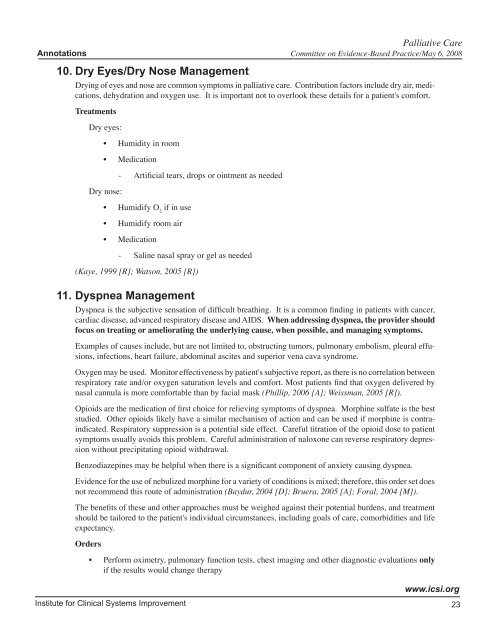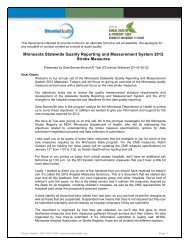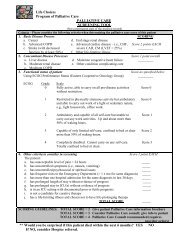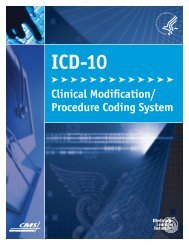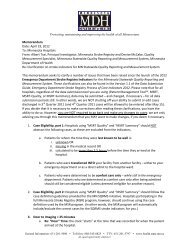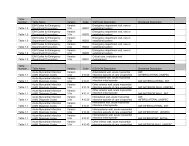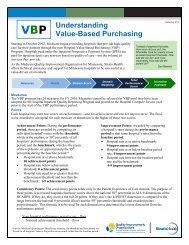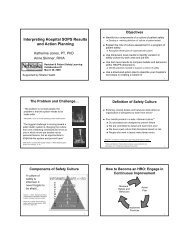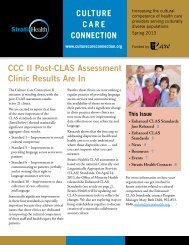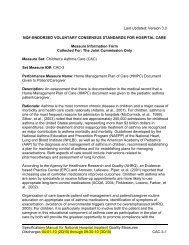Palliative Care Order Set - Stratis Health
Palliative Care Order Set - Stratis Health
Palliative Care Order Set - Stratis Health
Create successful ePaper yourself
Turn your PDF publications into a flip-book with our unique Google optimized e-Paper software.
<strong>Palliative</strong> <strong>Care</strong><br />
Annotations Committee on Evidence-Based Practice/May 6, 2008<br />
10. Dry Eyes/Dry Nose Management<br />
Drying of eyes and nose are common symptoms in palliative care. Contribution factors include dry air, medications,<br />
dehydration and oxygen use. It is important not to overlook these details for a patient's comfort.<br />
Treatments<br />
Dry eyes:<br />
• Humidity in room<br />
• Medication<br />
Dry nose:<br />
- Artificial tears, drops or ointment as needed<br />
• Humidify O 2<br />
if in use<br />
• Humidify room air<br />
• Medication<br />
- Saline nasal spray or gel as needed<br />
(Kaye, 1999 [R]; Watson, 2005 [R])<br />
11. Dyspnea Management<br />
Dyspnea is the subjective sensation of difficult breathing. It is a common finding in patients with cancer,<br />
cardiac disease, advanced respiratory disease and AIDS. When addressing dyspnea, the provider should<br />
focus on treating or ameliorating the underlying cause, when possible, and managing symptoms.<br />
Examples of causes include, but are not limited to, obstructing tumors, pulmonary embolism, pleural effusions,<br />
infections, heart failure, abdominal ascites and superior vena cava syndrome.<br />
Oxygen may be used. Monitor effectiveness by patient's subjective report, as there is no correlation between<br />
respiratory rate and/or oxygen saturation levels and comfort. Most patients find that oxygen delivered by<br />
nasal cannula is more comfortable than by facial mask (Phillip, 2006 [A]; Weissman, 2005 [R]).<br />
Opioids are the medication of first choice for relieving symptoms of dyspnea. Morphine sulfate is the best<br />
studied. Other opioids likely have a similar mechanism of action and can be used if morphine is contraindicated.<br />
Respiratory suppression is a potential side effect. <strong>Care</strong>ful titration of the opioid dose to patient<br />
symptoms usually avoids this problem. <strong>Care</strong>ful administration of naloxone can reverse respiratory depression<br />
without precipitating opioid withdrawal.<br />
Benzodiazepines may be helpful when there is a significant component of anxiety causing dyspnea.<br />
Evidence for the use of nebulized morphine for a variety of conditions is mixed; therefore, this order set does<br />
not recommend this route of administration (Baydur, 2004 [D]; Bruera, 2005 [A]; Foral, 2004 [M]).<br />
The benefits of these and other approaches must be weighed against their potential burdens, and treatment<br />
should be tailored to the patient's individual circumstances, including goals of care, comorbidities and life<br />
expectancy.<br />
<strong>Order</strong>s<br />
• Perform oximetry, pulmonary function tests, chest imaging and other diagnostic evaluations only<br />
if the results would change therapy<br />
www.icsi.org<br />
Institute for Clinical Systems Improvement<br />
23


